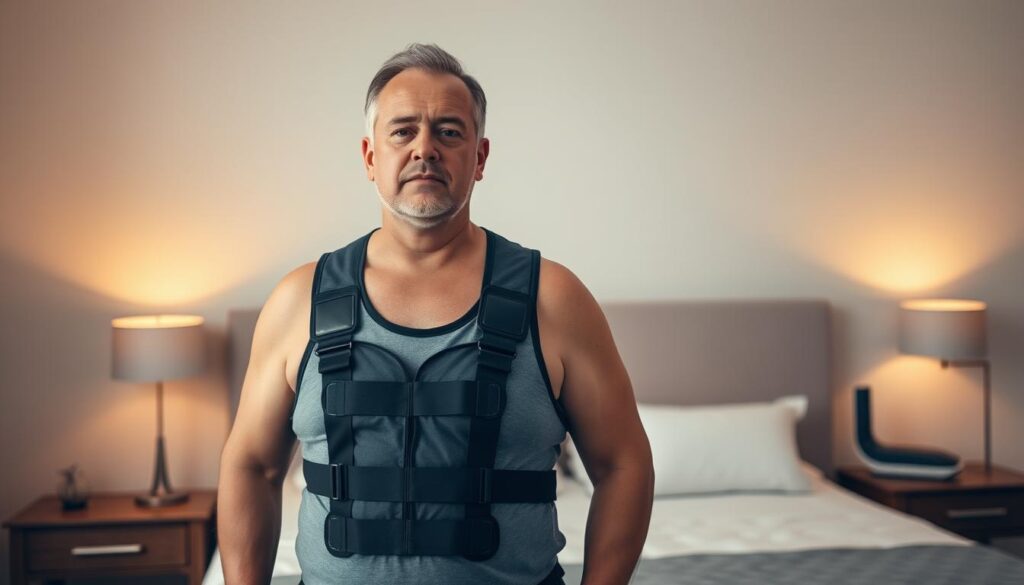
Did you know losing 10% of your body weight can cut sleep apnea severity by 25-30%? A University of Pennsylvania study found that reducing tongue fat—a hidden contributor to blocked airways—is key to improving breathing during sleep. With 22 million Americans affected by obstructive sleep apnea (OSA), this link between weight loss and sleep apnea offers a lifeline.
Obstructive sleep apnea occurs when throat tissues block airways during sleep. Excess weight adds fat to the neck and throat, worsening breathing stops. The MIMOSA trial tracked 264 adults with type 2 diabetes and OSA.
Those in the intensive lifestyle intervention (ILI) group lost 10.8kg over a year versus 0.6kg in the control group. Their apnea-hypopnea index (AHI) scores dropped by 9.7 events per hour, cutting severe OSA cases by half. Even small weight loss improves sleep quality and OSA symptoms.
Key Takeaways
- A 10% weight loss improves OSA severity by 25-30%, while gaining 10% worsens it by 40%.
- Participants in the ILI group lost 10.8kg, cutting AHI scores by 9.7 events per hour.
- 13.6% of ILI group achieved full OSA remission versus 3.5% in the control group.
- Weight loss of 10kg+ led to the largest reductions in AHI scores.
- Reducing tongue fat through lifestyle changes directly improves airway space.
Understanding the Connection Between Weight and Sleep Apnea
Obesity and sleep apnea are closely linked. Over 39 million U.S. adults have obstructive sleep apnea (OSA). This condition makes breathing stop during sleep. For those who are obese, the risk is much higher.
Pharyngeal fat deposits in the neck and tongue can narrow airways. Abdominal fat also limits lung expansion. These factors make it crucial to address both obesity and sleep apnea.
What Is Sleep Apnea and How Does It Affect Your Body?
OSA happens when throat muscles relax, blocking airflow. This leads to snoring, gasping, and poor sleep. Over time, it can harm your heart, metabolism, and brain.
Studies show 63% of obese adults and nearly 60% of obese children have moderate-to-severe OSA.
Why Excess Weight Contributes to Sleep Apnea
Excess body fat changes your body in three ways:
- Pharyngeal fat narrows airways
- Abdominal fat reduces chest expansion
- Increased tongue fat volume obstructs airflow
A 2014 study found losing 10% of body weight reduced tongue fat by 10%. This made breathing easier. Penn Medicine researchers also found changes in throat muscles after weight loss.
The Vicious Cycle: Poor Sleep, Weight Gain, and Worsening Apnea
Poor sleep messes with your hunger hormones. It lowers leptin (the “fullness” hormone) and boosts ghrelin (the “hunger” hormone). This leads to cravings for unhealthy foods, making weight loss tough.
The cycle goes like this: poor sleep → increased appetite → weight gain → worsened OSA.
| Weight Category | OSA Prevalence |
|---|---|
| Normal Weight | 11% men / 3% women |
| Overweight | 21% men / 9% women |
| Obese | 63% men / 22% women |
Breaking this cycle starts with small steps. Losing 5-10% of your weight can reduce OSA by up to 31%. This creates a healthier loop of weight loss → better sleep → sustained progress.
The Science Behind How Weight Loss Improves Sleep Apnea
Weight loss is more than just a number on the scale. It’s a way to help your airways breathe better. Losing weight can make your throat muscles relax and improve airflow. Let’s explore how losing weight helps fight sleep apnea.

Your airways are like a narrow tunnel. Extra weight puts pressure on them. Studies show losing 10% of your body weight can reduce neck and tongue fat by up to 30%. This makes it easier for air to move through.
A 2019 study found losing 10 pounds can reduce tongue fat. This makes breathing at night easier.
- Fat Reduction: Neck and tongue fat shrink, widening air passages.
- Inflammation Control: Losing weight lowers body-wide inflammation, calming swollen airway tissues.
- Lung Power: Less belly fat allows lungs to expand fully, boosting oxygen intake during sleep.
| Weight Loss % | AHI Reduction | Impact on Breathing |
|---|---|---|
| 5–10% | 26% drop in AHI | Less snoring, fewer breathing pauses |
| 10% | 50% symptom improvement | Reduced nighttime wake-ups and daytime fatigue |
Every kilogram lost is important. One study found losing 1 kg reduced AHI by 0.78 events per hour. Even small changes, like losing belly fat, help your diaphragm work better. This means weight loss and sleep quality get better together. When you lose weight, your body starts to breathe better, fighting weight loss and breathing disorders at their source.
Measurable Benefits of Weight Loss for Sleep Apnea Patients
Weight loss does more than just change your weight. It can really help with sleep apnea. For every kilogram you lose, your Apnea-Hypopnea Index (AHI) might go down by 0.78 events per hour. Losing 10–15% of your body weight can make OSA much less severe, or even make it go away.

| Study | Weight Loss | AHI Reduction | Remission Rate |
|---|---|---|---|
| Sleep AHEAD Trial | 11 kg average | 4.4/hour | 21% remission in ILI group |
| 12-Month Intervention | 18 kg loss | 21/hour drop | 44% improvement vs. 18% control |
- A 10% weight reduction can lower AHI by up to 36 events/hour.
- Even without major weight loss, exercise alone reduced AHI by 4 events/hour in men.
- Bariatric surgery patients saw AHI drop by 38.2 with BMI reductions, though long-term remission remains low (4%).
These numbers mean real changes in your life. You might breathe better at night, feel more awake during the day, and have better blood pressure. Since about 40% of OSA cases are due to being overweight, losing just 5–10 pounds can help.
Imagine waking up feeling refreshed, needing your CPAP machine less, or hearing your partner say you sleep well. That’s what benefits of weight loss for sleep apnea can do. Every kilogram matters, so start small and keep track with your doctor.
Effective Weight Loss Strategies When You Have Sleep Apnea
Small steps can lead to big changes in weight loss strategies for sleep apnea. Losing 5-10% of your body weight can help. It can reduce snoring and breathing pauses during sleep. This improves your overall health. Let’s break down practical steps tailored to your needs.
Dietary Approaches:
- Time meals wisely: Avoid heavy meals 2-3 hours before bed to prevent digestive discomfort and airway pressure.
- Focus on anti-inflammatory foods like leafy greens, fatty fish, and nuts to reduce throat tissue swelling.
- Stay hydrated but limit fluids before bedtime to avoid nighttime bathroom trips.
“Behavioral modifications, including consistent sleep hygiene practices, can enhance weight loss outcomes and improve sleep quality for individuals with sleep apnea.”
Exercise Recommendations:
Start with morning walks or gentle yoga to boost daytime energy. Studies show even moderate exercise—like 30 minutes of brisk walking 3x weekly—can improve breathing patterns. Avoid intense evening workouts, as they might disrupt sleep.
Track progress weekly, celebrating small wins. Aim for gradual change: ½ to 1 pound loss per week through balanced eating and activity. Remember, a 10% weight loss can cut sleep apnea episodes by up to 30%, as seen in clinical studies.
Pair efforts with sleep aids like CPAP therapy if needed. Over time, better sleep from sleep apnea treatment through weight loss can boost energy. This makes healthy habits feel achievable. Every step forward supports your body’s ability to heal—and rest—better.
Weight Loss and Sleep Apnea: Success Stories and Statistics
Real success stories and scientific data show how sleep apnea treatment through weight loss can change lives. Imagine losing just 10–15% of your body weight and cutting your apnea in half. That’s what many have achieved.

“After losing 50 pounds, my AHI score dropped from 40 to 8—no more CPAP machine needed!” – Sarah, 42
Real Stories of Transformation
- A 56-year-old man with severe OSA reduced his BMI from 45 to 33, cutting his AHI from 51 to 15 after gastric bypass surgery.
- A 34-year-old woman lowered her BMI from 38 to 30 through diet and exercise, achieving complete remission of mild OSA.
Research Proves the Link
The Sleep AHEAD study followed 264 obese patients. Those in weight loss impact on sleep apnea programs saw 34% remission rates. This was compared to 22% in control groups. Every kilogram lost reduced AHI by 3 events/hour. Recent studies at SLEEP 2023 show a 52.8% average AHI drop after 20% weight loss.
How Much Weight Loss Matters
Even small changes can make a big difference. Losing 5–10% of body weight can:
- Cut AHI by 26% (based on longitudinal studies)
- Reduce OSA severity by half in many cases
Severe cases may need 15–20% loss for full improvement. Surgery like Roux-en-Y gastric bypass can slash AHI by 60% in morbidly obese patients.
Overcoming Challenges in Your Weight Loss Journey with Sleep Apnea
Managing weight loss and sleep apnea is tough. Fatigue from poor sleep makes it hard to exercise or cook. But, taking small steps can help.

“Progress isn’t about perfection—it’s about moving forward, even when tired.”
- Start with sleep first: Use a CPAP machine or oral appliance to improve breathing at night. Better sleep boosts daytime energy, making physical activity easier.
- Shorten workouts: Aim for 10-minute walks or stretching sessions. Even light movement reduces inflammation and supports how weight loss improves sleep apnea over time.
- Plan ahead: Prep meals on days with more energy. Pre-chopped veggies or frozen healthy meals save time when fatigue hits.
- Seek support: A dietitian can design easy-to follow meal plans. Therapy or support groups help address emotional eating linked to sleep deprivation.
Research shows even modest weight loss reduces apnea episodes. For example, a JAMA study found that losing 10% of body weight cut breathing pauses during sleep. Work with your doctor to create a plan that includes sleep therapy and lifestyle changes. Celebrate small victories, like a 15-minute walk or a balanced meal. Lean on your team for support. Over time, these steps will help you get healthier.
Conclusion: Breathing Easier Through Healthy Weight Management
Managing your weight is more than just looking good. It’s key to quieter nights and more energy. Over 22 million Americans have sleep apnea, with 41% linked to being overweight. A 10-year study showed that lifestyle changes helped 34% of people get better, compared to 22% in the control group.
Weight loss for sleep apnea has big benefits. It lowers heart disease risks and boosts overall health. Starting with small, lasting changes is the best approach.
Losing 5–10% of body weight can help a lot. Studies show that losing belly and tongue fat improves breathing. A balanced diet and regular exercise, like brisk walks or yoga, are great for lasting change.
Always talk to your doctor before starting any plan. While CPAP therapy helps many, lifestyle changes can lead to better results. Start by tracking your meals or adding a 15-minute walk.
Even small weight loss, like 10–20 pounds, can make a big difference. It can reduce airway blockages and help you breathe better. Every step toward healthier habits brings you closer to better sleep and a brighter morning.












